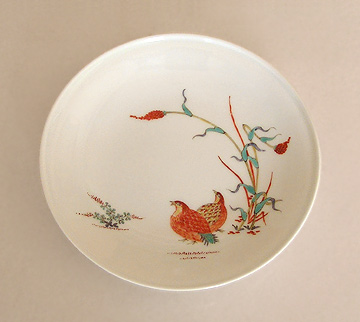|
||
 |
||

Kakiemon `Eqε
@
(C)2001 Japanese Architecture and Art Net Users System.@No reproduction or republication without written permission.
fΪΜeLXgEΚ^ECXgΘΗASΔΜRecΜ³f‘»E]ΪπΦΆά·B
|
||||||
| @ | ||||||
| imariyaki@Ι’Δ | ||||||
| KEY WORD :@art history / crafts | ||||||
| @ | ||||||
| Imari ware. A general term for porcelain from the Arita Lc region of Saga prefecture, but not including the Kakiemon `Eqε and Nabeshima η kilns. The name derives from the port of Imari from where imariyaki was shipped to cities in Japan, China and Europe. The ware is noted for variations on Chinese decorative techniques and styles. The Chinese method of first decorating a vessel with blue underglaze and firing it at relatively high temperatures, then enameling the resulting porcelain with overglaze colors followed by a second firing at a reduced heat, was introduced to Japan in the Keichou c· era (1596-1615). Imariyaki made through the Genroku ³\ era (1688-1704) is called ko-imari ΓΙ’ (old Imari) or shoki-imari ϊΙ’ (early Imari) and includes *sometsuke υt (blue-and-white china), seiji Β₯ (celadon porcelain), seiji-sometsuke Β₯υt (celadon with blue-and-white decoration) and *iro-e FG (polychrome ware). Characteristic iroe imari features dramatic motifs of Japanese genre scenes, Dutch and Chinese ships, and birds-and-flowers often rendered in colors that depart as far as possible from nature glazed onto unusually-shaped vessels. From the mid Edo period, Imari ware was exported to Europe by the Dutch West India Company and greatly influenced European porcelain production. | ||||||
| @ | ||||||
 Kakiemon `Eqε
|
||||||
@ |
||||||
| REFERENCES: | ||||||
| @ | ||||||
| EXTERNAL LINKS: | ||||||
| @@ | ||||||
| NOTES: | ||||||
| @ | ||||||
(C)2001 Japanese Architecture and Art Net Users System.@No reproduction or republication without written permission. fΪΜeLXgEΚ^ECXgΘΗASΔΜRecΜ³f‘»E]ΪπΦΆά·B |
||||||
| @ |